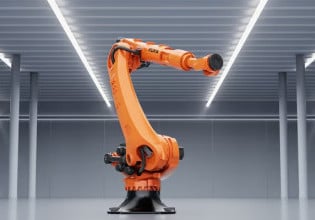New Vision Sensor from Keyence Designed to Unlock Capabilities in AI and Machine Learning
What are vision sensors and how can engineers use them in critical inspection and detection tasks?
Keyence supplies and manufacturers automation and vision inspection components. Their product line includes barcode readers, laser markers, vision systems, and a variety of sensors, just to name a few. The company recently launched a new vision sensor with AI capabilities.
IV3 Series
This particular vision sensor has an integrated wide field of view lens, automatic focus, IP67 rated, power over Ethernet (PoE), integrated white or inferred lighting, and comes in two models, standard or compact.

A diagram showing the features of the new sensor. Image used courtesy of Keyence
This vision sensor is unique because of all of the features above as well as the AI-based detection. Another great feature is the compact model. Measuring 1.22” high by 0.94” wide by 1.74” long, this sensor can fit into many small places without sacrificing functionality.
Integrated Vision Systems
An integrated vision system means that the lighting, lens, and focus are all contained within the housing of the camera body. This style of vision sensor can be very useful when used for simple part or flaw detection. When the vision application becomes complex, an integrated solution just will not work as well. Adding AI to the vision tools included with the IV3 series is a great way to increase the usability of a compact, easy-to-source, and use, vision solution.
AI in Vision Systems
AI or artificial intelligence has recently made its way into industrial vision sensors over the last couple of years. AI is used along with pattern matching or other vision tools to detect failures without teaching thousands of images. At the beginning of developing an AI vision program, the tools will look the same. The difference comes when teaching the camera what a good part is and what is a bad part.

Keyence’s new vision sensor. Image used courtesy of Keyence
Typical vision tools require multiple sets of good and bad images, but with AI, only a few are required. Once the detection areas are taught, the AI algorithm takes over and produces a set of images out of thousands with different image conditions. The user then selects between four to 12 images with the best results. This provides the AI program with the necessary parameters when running in production. Using AI in vision systems can be a great way to speed up the integration of vision applications.

A breakdown of how AI is used in the sensor. Image used courtesy of Keyence
These sensors can be used in a broad range of industries. Below are some examples of where this sensor could be used.
Vision-guided robots are a great way to increase the accuracy in robot applications. Robots are known to be inaccurate but are repeatable with respect to their taught positions. Adding a vision system to the application greatly increases the robot’s accuracy. The most time-consuming part of developing a vision-guided robot system is ensuring the vision system is accurately detecting the part location. With an AI vision system, this time can be greatly reduced.
Part Flaw Detection is a great application for a vision system if the components can be seen easily. With the IV3 color detection and AI programming, a user can quickly and easily set up a vision detection system. Simply mark the region where you want the vision program to detect and teach good and bad parts, the AI algorithm will do the rest.
This new vision sensor from Keyence may play a crucial role in helping engineers streamline their inspection and detection tasks.






